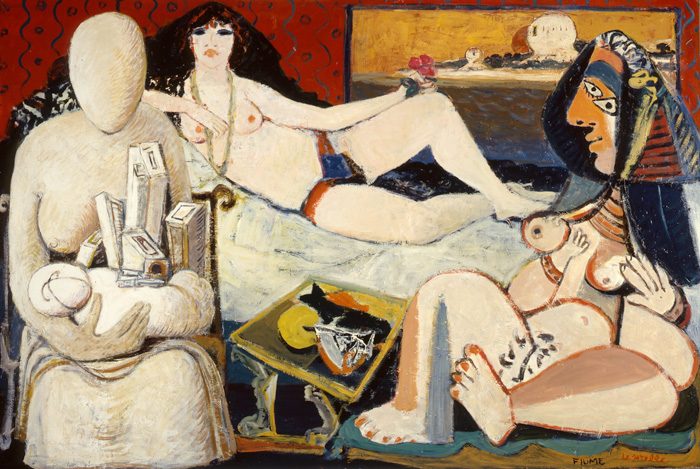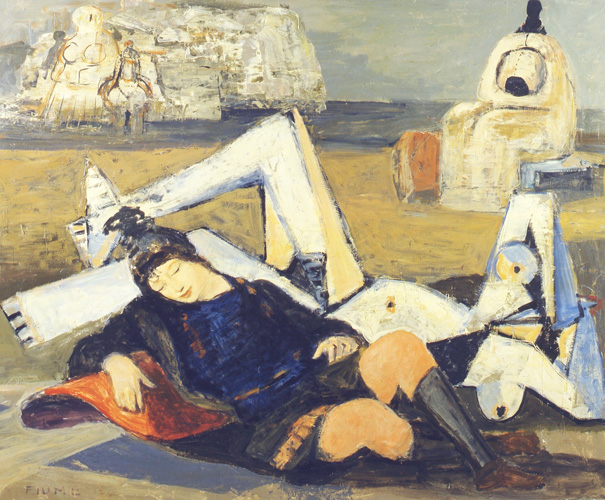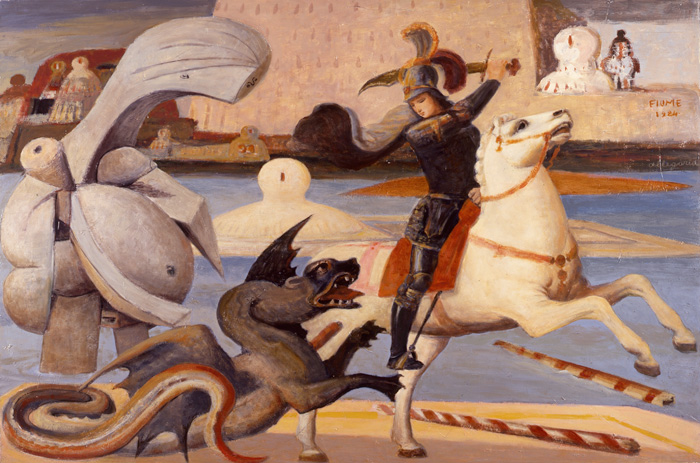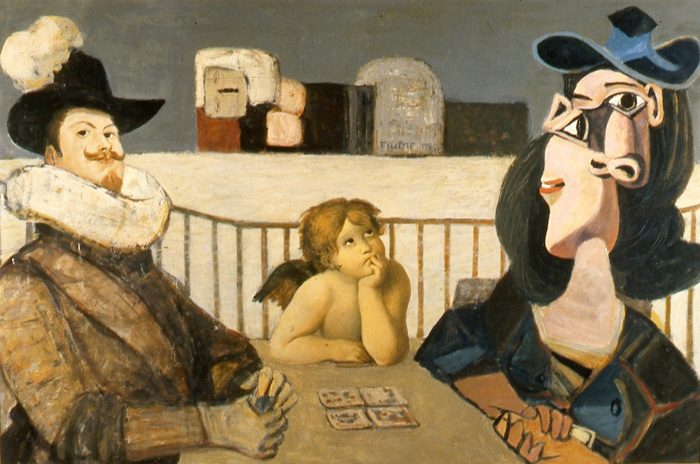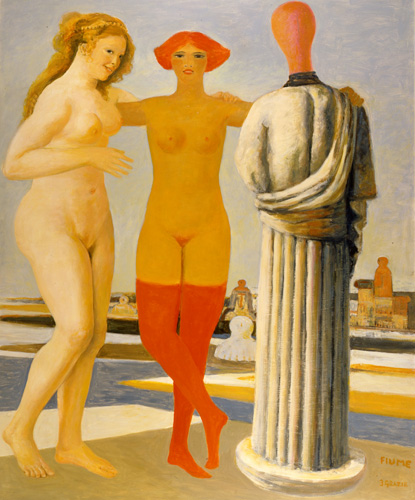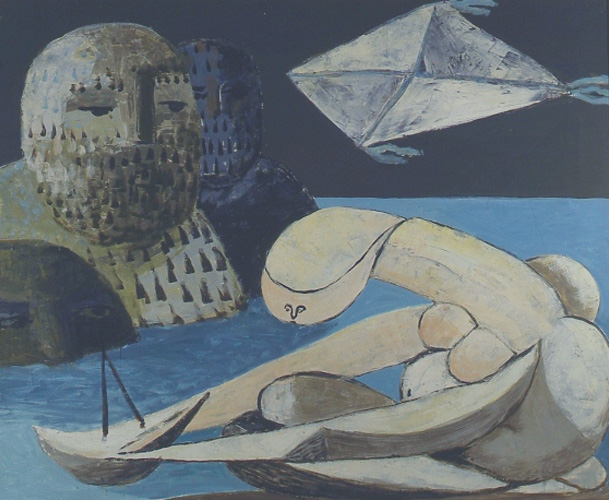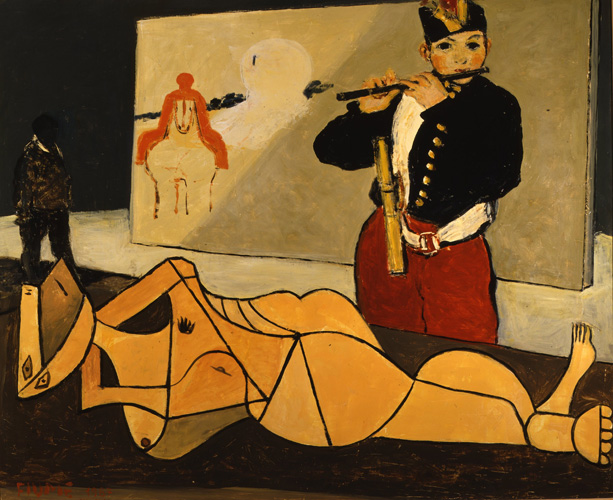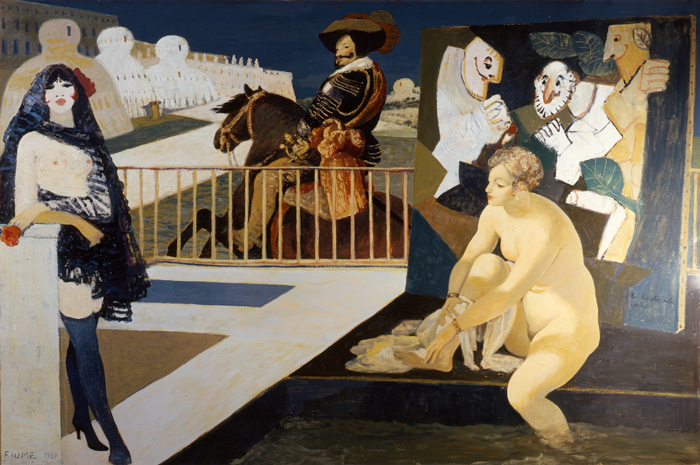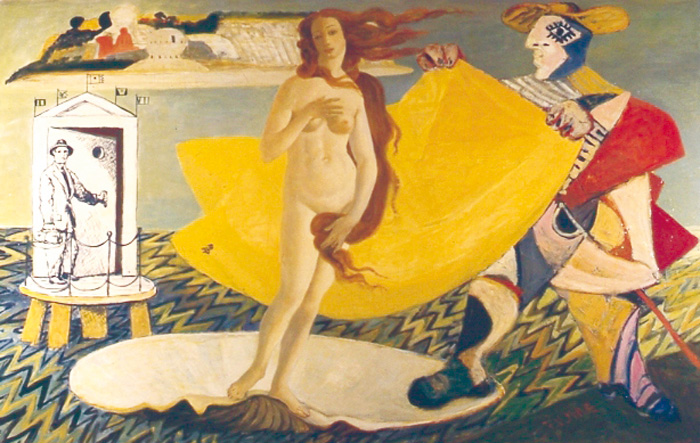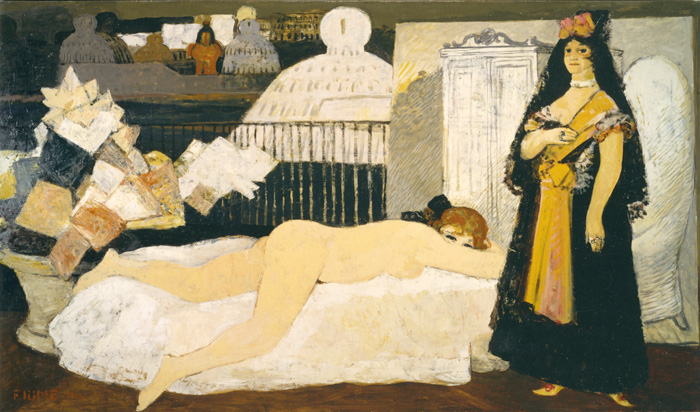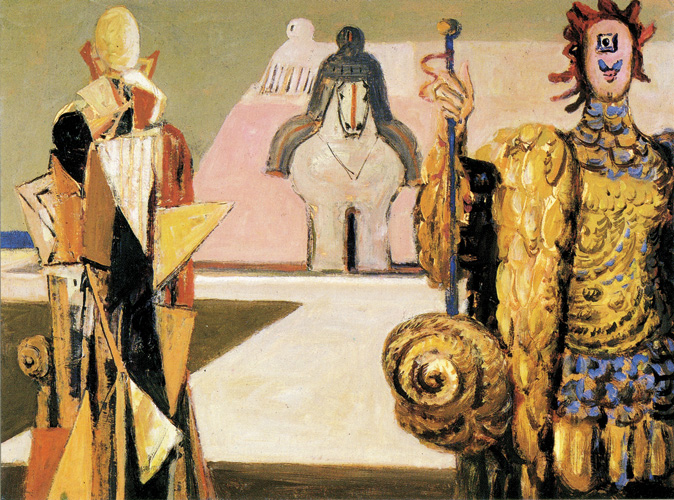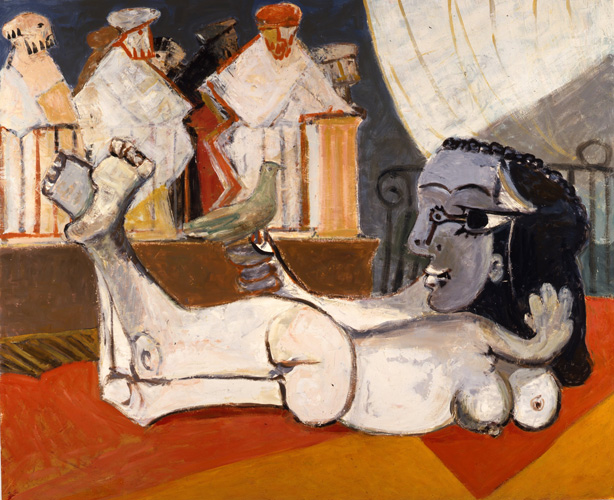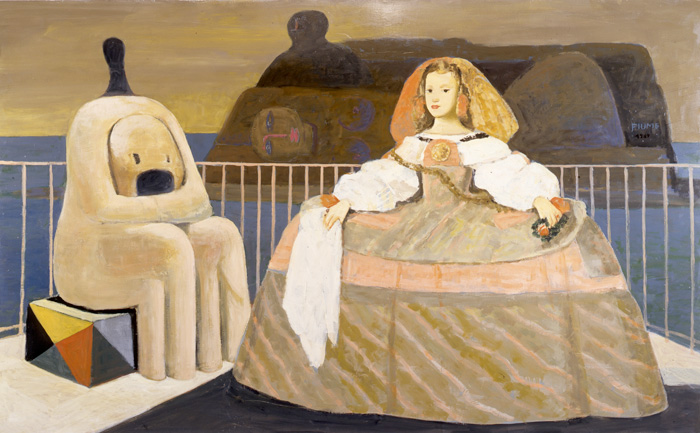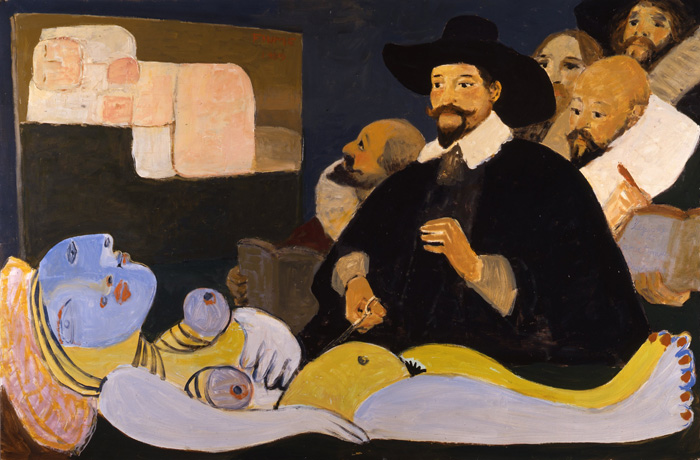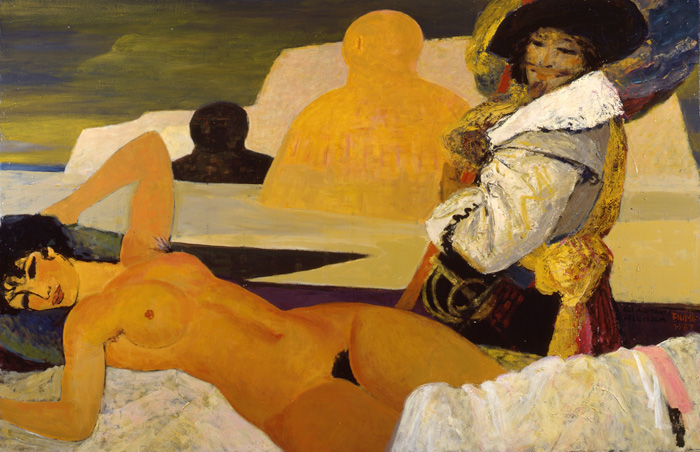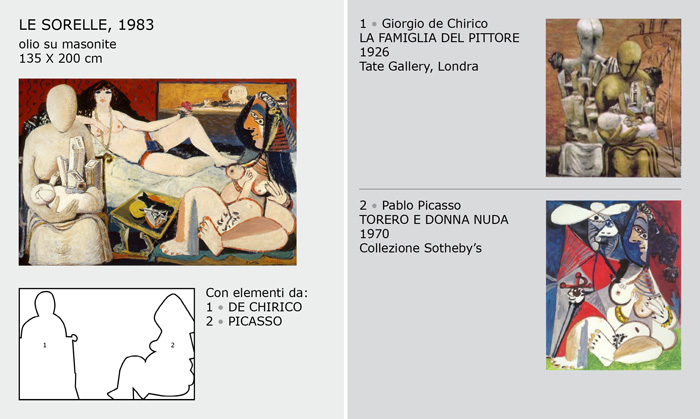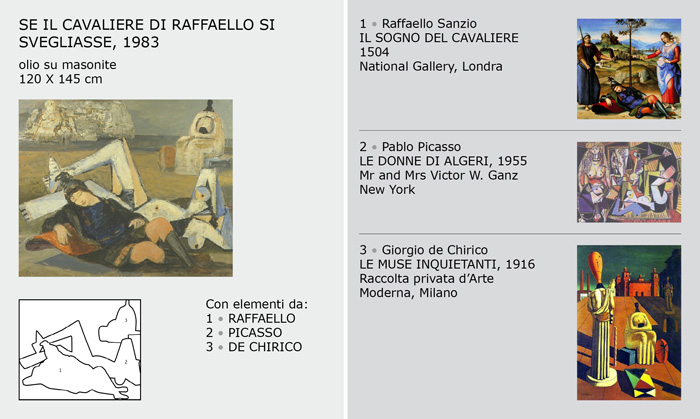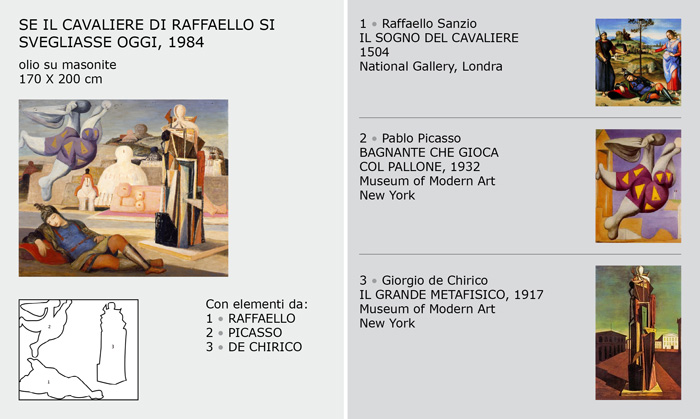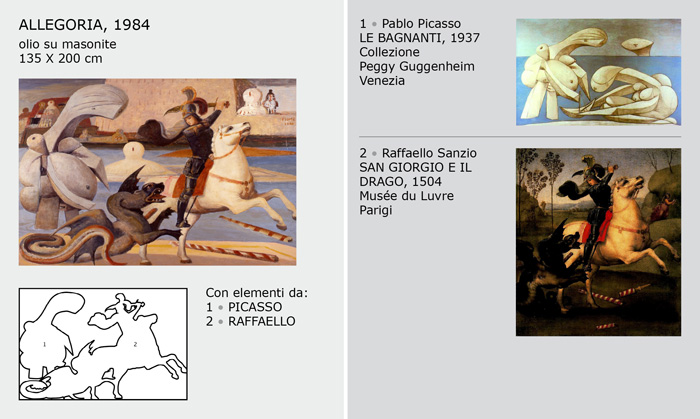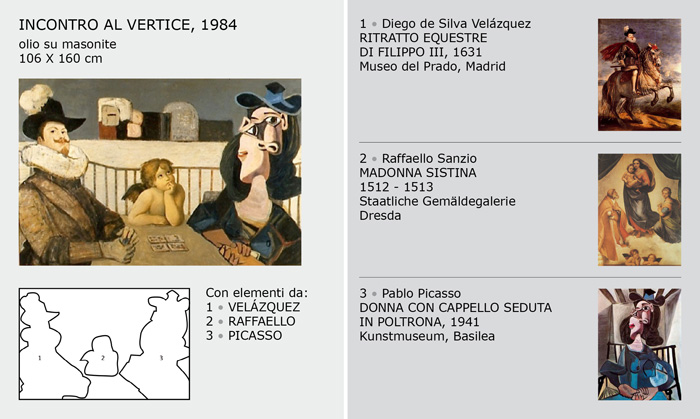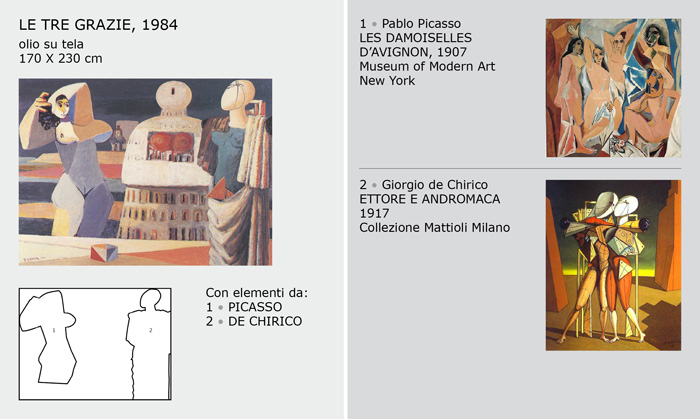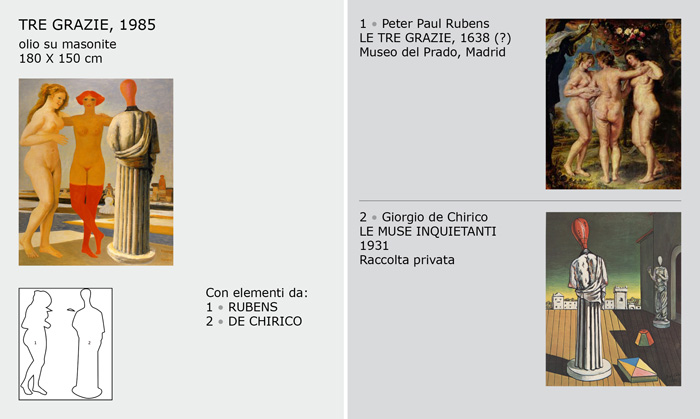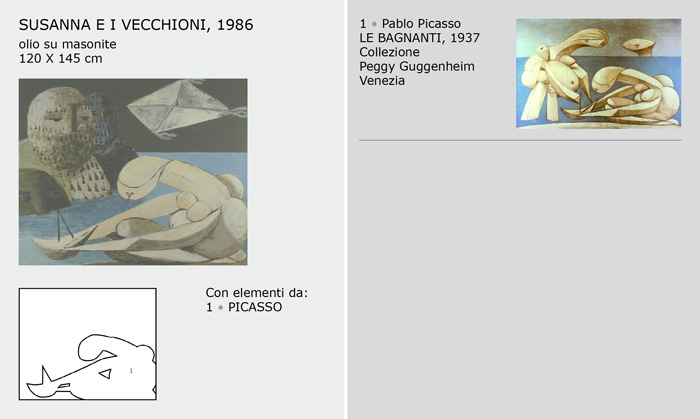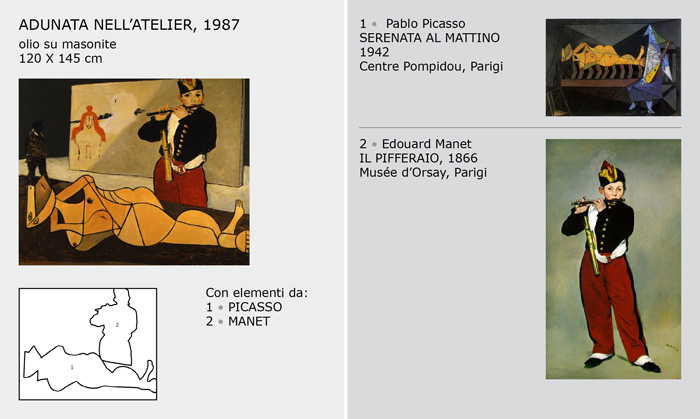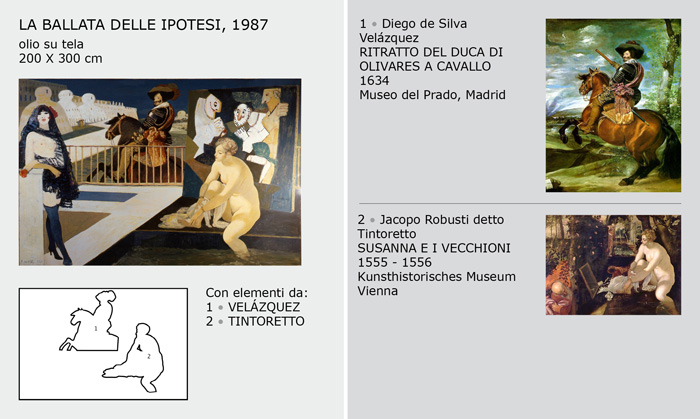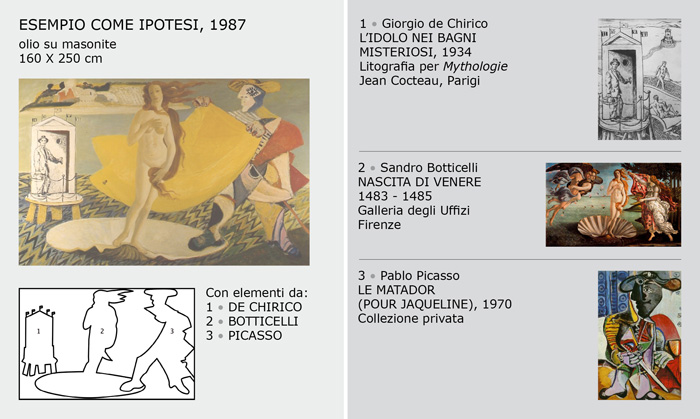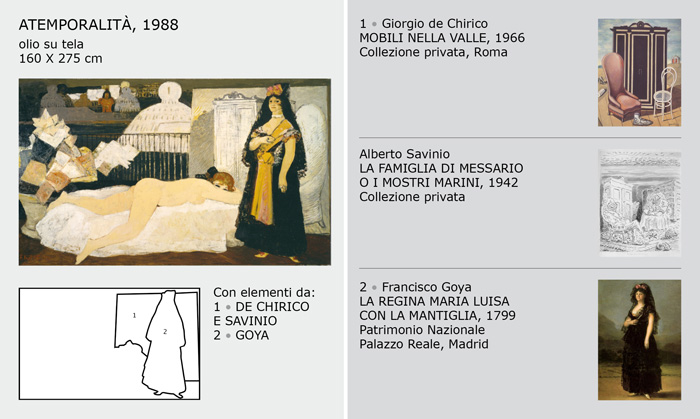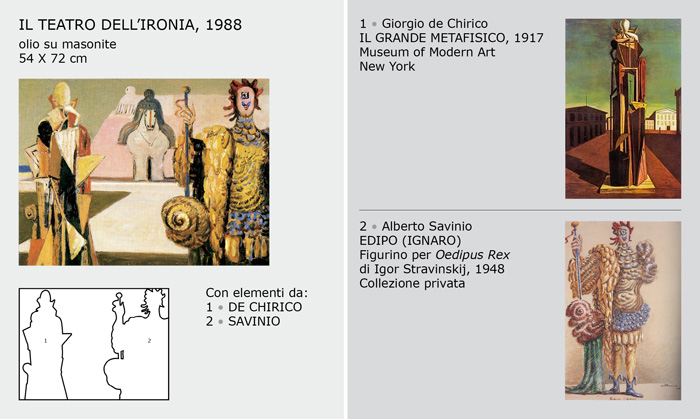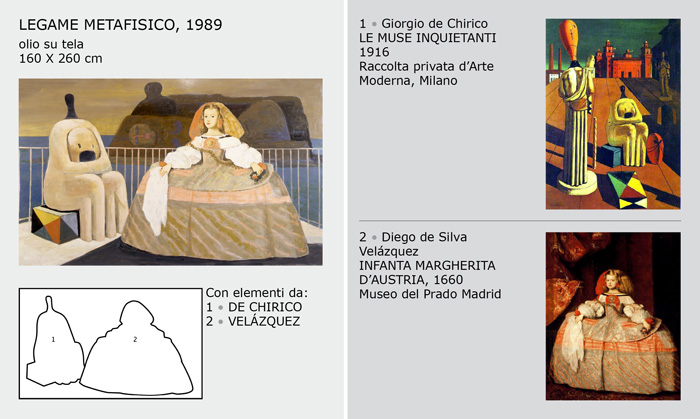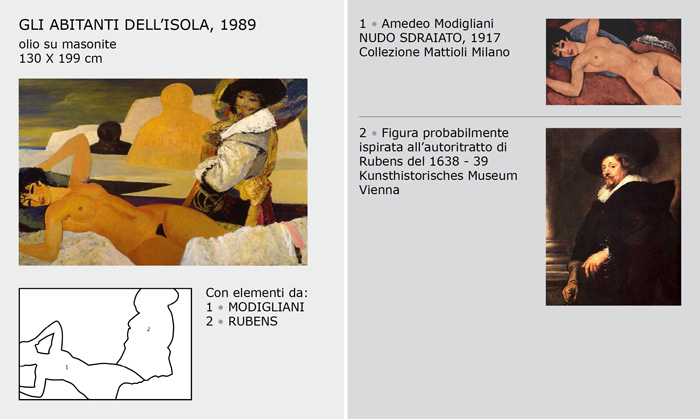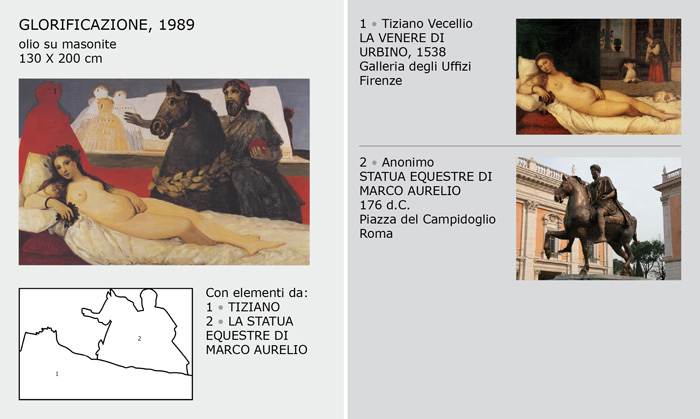THE HYPOTHESES
1983 · 1992
In the eighteen paintings forming the cycle of The Hypotheses, on the background of images typical of Fiume’s work such as the Islands of Statues, or beside some of his female figures, we find elements from works of modern painters like Manet, Picasso, and de Chirico juxtaposed to or intertwined with figures from ancient painters like Botticelli, Tintoretto, Raphael, Rembrandt, Rubens, and Velázquez. By blending parts from various historical masterpieces with elements of his own painting, Fiume exemplified a concept he was very fond of: that of the contemporariness of all art. As a result, through his Hypotheses Fiume has provided us with a highly personal summa of European painting from the Renaissance to the 20th Century, implicitly proposing himself as the last heir, among his contemporaries, of that great tradition.
A STUDY OF THE HYPOTHESES
CRITICAL TEXTS
from Timeless Fiume
Fiume in Moscow
Augusto Tota Publisher, Parma, 1991
…Fiume looks at Goya and Manet, draws upon, re-elaborates, and reconstructs the painting of modern masters and, by ignoring whatever has not yet entered that real history which is our memory, and therefore avoiding any dialogue with the avant- garde movements, the contemporary artists, and the seekers of new paths, he keeps demonstrating that poetry, like great painting, denies history, denies time and overturns the regular order of things and the chronological unfolding of events. His pictorial parable translates Borges’ theory into images. What comes earlier is not necessarily before, and in order to be able to organize one’s appraisal, one must place himself at the end of a historical journey. If we look at the history of painting from Giotto to the Impressionists, we realize that not only there is no evolution, not only there is no growth, but that we could ideally set up a competition among artists picking them from different centuries. In an inverted course of this kind, the first one would not be the first, nor would he be the last one. Within such a logic, Piero della Francesca would come in first place, Caravaggio in second, Giotto in third, then a painter from the XV century, one from the XVII century, and one from the XIV, or any other possible arrangement that would allow us to set primacies without following any pre-established order. Such wiles of the memory against the organization of history, such unforeseeable primacies find a perfect representation in those paintings of Fiume’s where he puts together Raphael, de Chirico, Henry Moore and makes them live within a perfectly credible space, almost normalizing the differences of images and styles. There is a Fiume style that manages, while respecting de Chirico’s and of Raphael’s characteristics, to make their coexistence plausible; therefore, a Fiume style against the styles or a style against the appropriation of styles made by history. The painter we are looking at is not from the Seventeenth century, but from the Twentieth, another one is not from the Fourteenth but from the Twentieth, this one is not from the Sixteenth but from the Twentieth and does not belong to the early centuries, but to the centuries to come. Fiume gathers them all within the net of his own painting and brings them back to the starting-line for the race, he lines them up so as to eliminate their differences while preserving their distinctions, i.e.: the identities we have memorized which allow us to recognize de Chirico, Raphael, Velázquez, Manet, Giotto without preventing us from seeing them as contemporary. Thus Fiume’s choice is a declaration that makes the simple mechanism described above explicit: a mechanism by which poetry denies itself to fashion, leaves to the present time the body of those who make it, and moves into any other time. Fiume proves this through his images, so much so that Goya’s Majas are Fiume’s Majas, and our Majas, female figures from an unlimited and timeless obsession, contemporary images of eros, passion, love; accordingly, the lines relating to Silvia, Nerina or to any other poetical image have nothing to do with the real figure that has prompted them, because they have become the loves of our life, the loves of our personal history…
…A dialectical tension animates the life of a masterpiece in an “eccentric path” which never tends toward the recomposition of contrasts; rather, it lets them live within a higher bond towards a different and superior destination. «Through a higher unity – says Novalis – the artist achieves a concentration of various trades and these, through such higher concentration, acquire a higher meaning». When the painter, victorious and tenacious, operates upon the volumes, the bodies, the colours, then his connection to the old becomes present and effective; then we understand how the novelty of the ancient is the antiquity of the new; then we become aware of the unbroken continuity of time. This is precisely the horizon of Salvatore Fiume’s metaphysical painting where novelty, proposal, and hope keep originating from the living metamorphosis of the old. Thus the artist, in his own words, «can run backwards: run on the wake of time past ». If, as Benjamin states, «antiquity only exists where a creative spirit recognizes it», then Fiume’s poetics of the Hypotheses represents the paradigm of an intelligent dialogue between past and present articulated within a lively and persistent dialectical relationship between intuition and reflection, between the reception-perception of meaning and the foundation of new myths for the present. Is this, then, romantic art? Is this, to paraphrase a famous definition by Friedrich. Schlegel with reference to poetry, “Painting of painting”? Of course, romanticism is “romanticization”, a progressive movement of forms and meaning constantly being defined; yet, in Fiume reflection is always led by intuition, which is the deep and living study of the old and at the same time the identification of a new antiquity; which, in turn, is the formed-form and the forming-form of art’s and history’s time. Thus, Fiume’s painting represents the extraordinary sense of a complex, articulated, manifold, and profound modernity. It is, no doubt, an “educated” painting, voted to a genuine worship of forms, yet, at the same time, pregnant with an authentic power of myth-creation. And therefore, the inclusion of classical elements is no mere ornamental citation, nor just a form of mannerism; indeed it is the composition of living material within the warp and fabric of the history of soul. This is how the Hypotheses take shape: witnesses to a new and bewildering contemporariness of masterpieces. In his hypothesis the artist’s consciousness becomes awareness of the living time and thus an example of a possibility, perhaps of the highest one: the possibility of dialogue among times within time, among spaces within space, the amazing discovery of the eternal simultaneousness of artworks. «It is not news – says Fiume – that compared to the incalculable immensity of time, a few thousand years is equal to a few seconds». And therefore the eternal becomes the new and the hypothesis becomes the modern form of a new mythology. If, as the painter recognizes, «great artworks must have been begotten by great hypotheses», and if «every artwork is the materialization of a hypothesis», then the hypothesis is itself the imprint of a total artwork, the ineffaceable trace of a new language of the origins, in which the essence of a grand style, the essence of the “classic”, finds its foundation…
LUCA BEATRICE
from The Fiume Hypothesis
Catalogue of the exhibition Salvatore Fiume, a Nonconformist of the
Twentieth Century Spazio Oberdan, Milano 2011
…After nearly half a century of Minimalism, of cold objectivity delegating the final realisation to a specialist technician or to an industrial production system, we now see the return of the desire for sentimental adherence, of a private, intimate, feeling and sensual relationship with the material and its support. This being the current hot debate, we should therefore affirm that Salvatore Fiume has arrived at this conclusion a little less than thirty years ago, very surprisingly ahead of times. We are talking of about 1983 (when the Sicilian painter had already reached full maturity and notoriety) and particularly of that cycle of works known as The Hypotheses, both surprising and intuitive for an artist who is any way “labelled” a traditionalist, which was none other than his main means of expression, from the forties onwards, through painting. Yet let us take a step backwards. Salvatore Fiume is viewed as a 20th century anti- conformist, or as an artist intentionally beyond fashion, deliberately concentrated on his experimentation, little inclined to socialise with groups or join movements. All in all, a person who minded his own business, taking on board the undoubted advantages of originality and fluency of his own vagrant thought yet as much paying for the consequences, since it is undoubted that whoever acts as a loner must labour to find space within systematic grids. Let us instead dare proposing another, bolder, “Fiume Hypothesis”: or that the Sicilian painter was really a bit too progressive with respect to his times and that although he did it in a disorderly manner, without a precise strategy, he had that inner feeling that our epoch manages to read better than past times. The cycle in question, which was finished between 1983 and 1992, works as a painting “remix”, a brilliant anticipation of the theory of post-production which was fashionable in the nineties, yet rarely put into practice through canvases, colours and brushes. We thus find ourselves facing a radically conceptual approach to the painting, resounding for a pure figuration, at times (but at this point we are overcome with doubt) smeared with anachronism. With respect to de Chirico in his self-portrait, which Renato Barilli identifies as the archetype of conceptual painting (I am referring to the exhibition Repetition with a difference presented by him at the Studio Marconi in Milan in 1974), Fiume makes a decisive leap forward. He chooses to “host” within his canvases replicas of works by other colleagues, putative fathers, reference points: if, on the one hand we might consider them as mere tributes to those fathers, on the other it seems more convincing to think that he wished in some degree, and with irony, to consecrate himself within art history, which indeed is “all contemporary”, and which is what more or less most hope for. The originality of the project thus consists of the horizontal reading of history, a whole space where different things can coexist in a kind of abstract and unconventional non-time…

